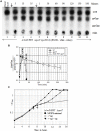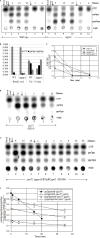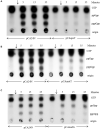Studies on the Regulation of (p)ppGpp Metabolism and Its Perturbation Through the Over-Expression of Nudix Hydrolases in Escherichia coli
- PMID: 33178149
- PMCID: PMC7593582
- DOI: 10.3389/fmicb.2020.562804
Studies on the Regulation of (p)ppGpp Metabolism and Its Perturbation Through the Over-Expression of Nudix Hydrolases in Escherichia coli
Abstract
Stringent response mediated by modified guanosine nucleotides is conserved across bacteria and is regulated through the Rel/Spo functions. In Escherichia coli, RelA and SpoT proteins synthesize the modified nucleotides ppGpp and pppGpp, together referred to as (p)ppGpp. SpoT is also the primary (p)ppGpp hydrolase. In this study, using hypomorphic relA alleles, we provide experimental evidence for SpoT-mediated negative regulation of the amplification of RelA-dependent stringent response. We investigated the kinetics of ppGpp degradation in cells recovering from stringent response in the complete absence of SpoT function. We found that, although greatly diminished, there was slow ppGpp degradation and growth resumption after a lag period, concomitant with decrease in ppGpp pool. We present evidence for reduction in the ppGpp degradation rate following an increase in pppGpp pool, during recovery from stringent response. From a genetic screen, the nudix hydrolases MutT and NudG were identified as over-expression suppressors of the growth defect of ΔspoT and ΔspoT ΔgppA strains. The effect of over-expression of these hydrolases on the stringent response to amino acid starvation and basal (p)ppGpp pool was studied. Over-expression of each hydrolase reduced the strength of the stringent response to amino acid starvation, and additionally, perturbed the ratio of ppGpp to pppGpp in strains with reduced SpoT hydrolase activity. In these strains that do not accumulate pppGpp during amino acid starvation, the expression of NudG or MutT supported pppGpp accumulation. This lends support to the idea that a reduction in the SpoT hydrolase activity is sufficient to cause the loss of pppGpp accumulation and therefore the phenomenon is independent of hydrolases that target pppGpp, such as GppA.
Keywords: (p)ppGpp; RelA; SpoT; nudix hydrolases; stringent response.
Copyright © 2020 Sanyal, Vimala and Harinarayanan.
Figures







Similar articles
-
Interaction of alleles of the relA, relC and spoT genes in Escherichia coli: analysis of the interconversion of GTP, ppGpp and pppGpp.Mol Gen Genet. 1977 Jan 7;150(1):87-101. doi: 10.1007/BF02425329. Mol Gen Genet. 1977. PMID: 319345
-
Activation of RelA by pppGpp as the basis for its differential toxicity over ppGpp in Escherichia coli.J Biosci. 2020;45:28. J Biosci. 2020. PMID: 32020910
-
(p)ppGpp controls stringent factors by exploiting antagonistic allosteric coupling between catalytic domains.Mol Cell. 2021 Aug 19;81(16):3310-3322.e6. doi: 10.1016/j.molcel.2021.07.026. Mol Cell. 2021. PMID: 34416138
-
(p)ppGpp Metabolism and Antimicrobial Resistance in Bacterial Pathogens.Front Microbiol. 2020 Oct 9;11:563944. doi: 10.3389/fmicb.2020.563944. eCollection 2020. Front Microbiol. 2020. PMID: 33162948 Free PMC article. Review.
-
(p)ppGpp and the bacterial cell cycle.J Biosci. 2016 Jun;41(2):277-82. doi: 10.1007/s12038-016-9611-3. J Biosci. 2016. PMID: 27240988 Review.
Cited by
-
Overexpression of pEGF improved the gut protective function of Clostridium butyricum partly through STAT3 signal pathway.Appl Microbiol Biotechnol. 2021 Aug;105(14-15):5973-5991. doi: 10.1007/s00253-021-11472-y. Epub 2021 Aug 16. Appl Microbiol Biotechnol. 2021. PMID: 34396488
-
Derivatives of Esculentin-1 Peptides as Promising Candidates for Fighting Infections from Escherichia coli O157:H7.Antibiotics (Basel). 2022 May 13;11(5):656. doi: 10.3390/antibiotics11050656. Antibiotics (Basel). 2022. PMID: 35625300 Free PMC article.
-
Photoaffinity Capture Compounds to Profile the Magic Spot Nucleotide Interactomes.Angew Chem Int Ed Engl. 2022 May 23;61(22):e202201731. doi: 10.1002/anie.202201731. Epub 2022 Mar 30. Angew Chem Int Ed Engl. 2022. PMID: 35294098 Free PMC article.
-
Sound the (Smaller) Alarm: The Triphosphate Magic Spot Nucleotide pGpp.Infect Immun. 2023 Apr 18;91(4):e0043222. doi: 10.1128/iai.00432-22. Epub 2023 Mar 15. Infect Immun. 2023. PMID: 36920208 Free PMC article. Review.
References
LinkOut - more resources
Full Text Sources

